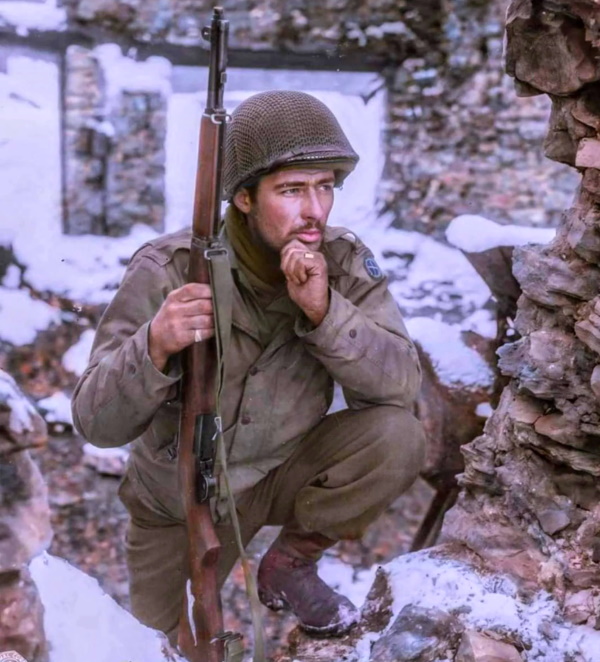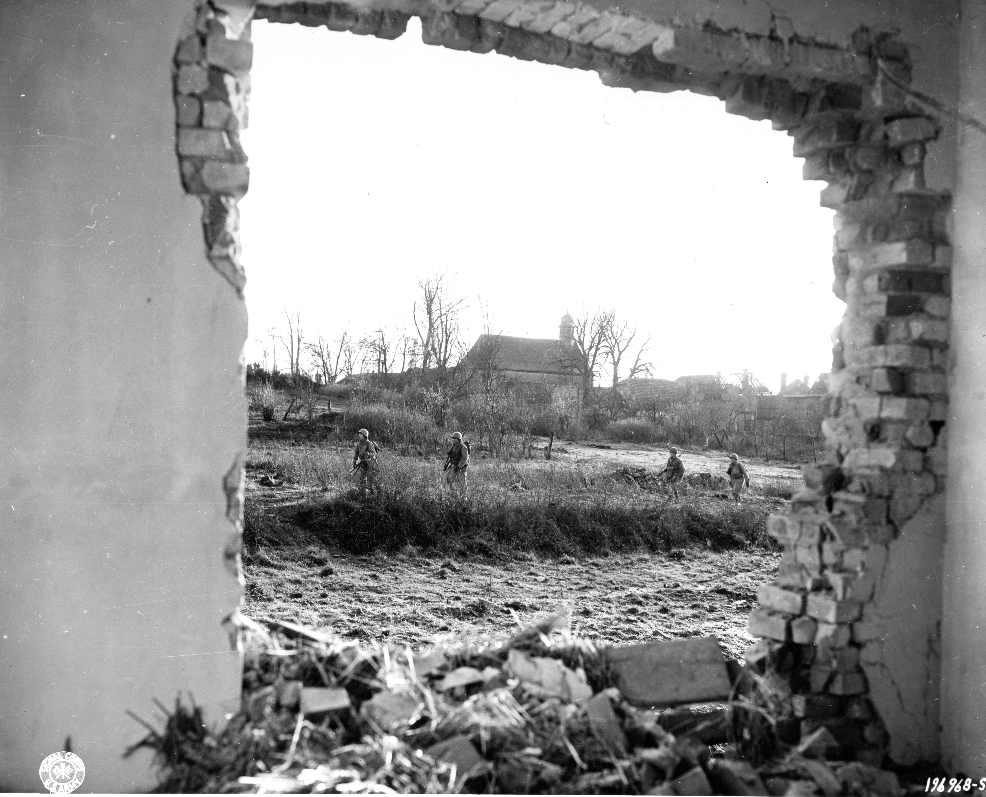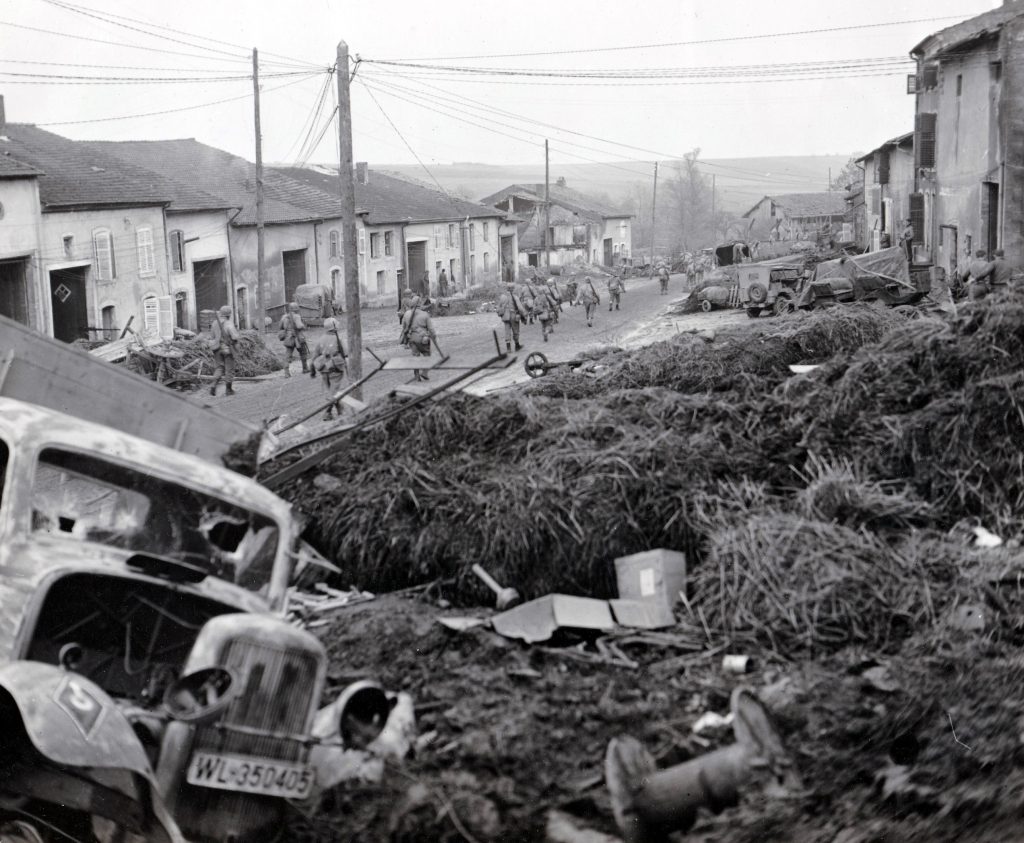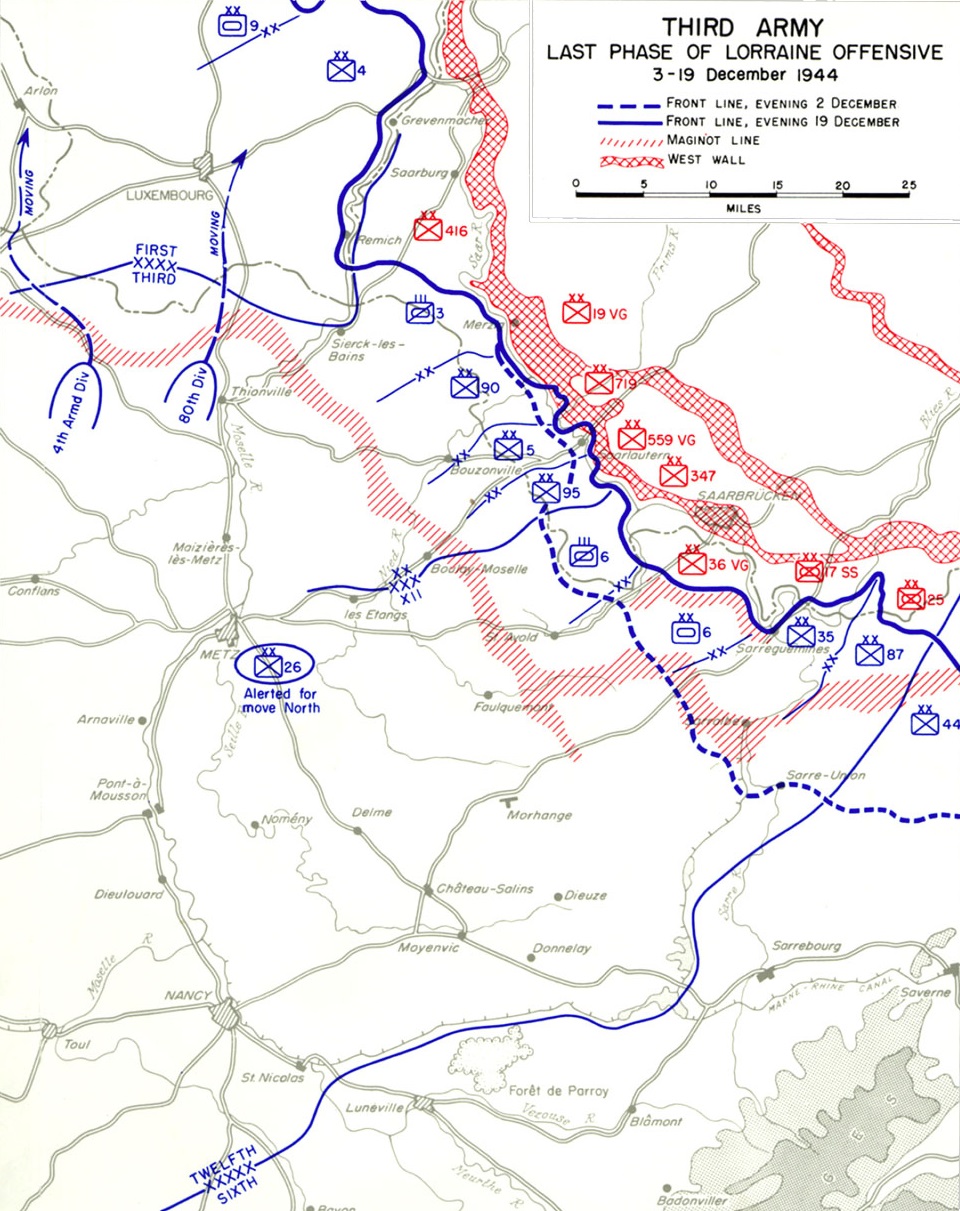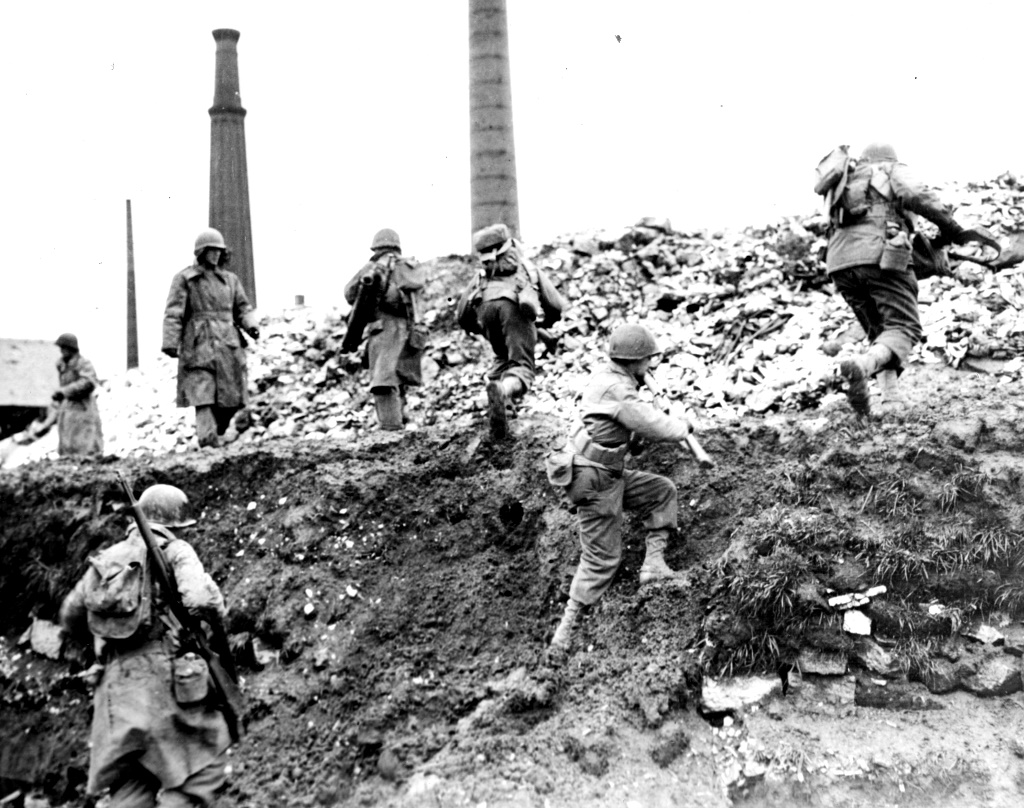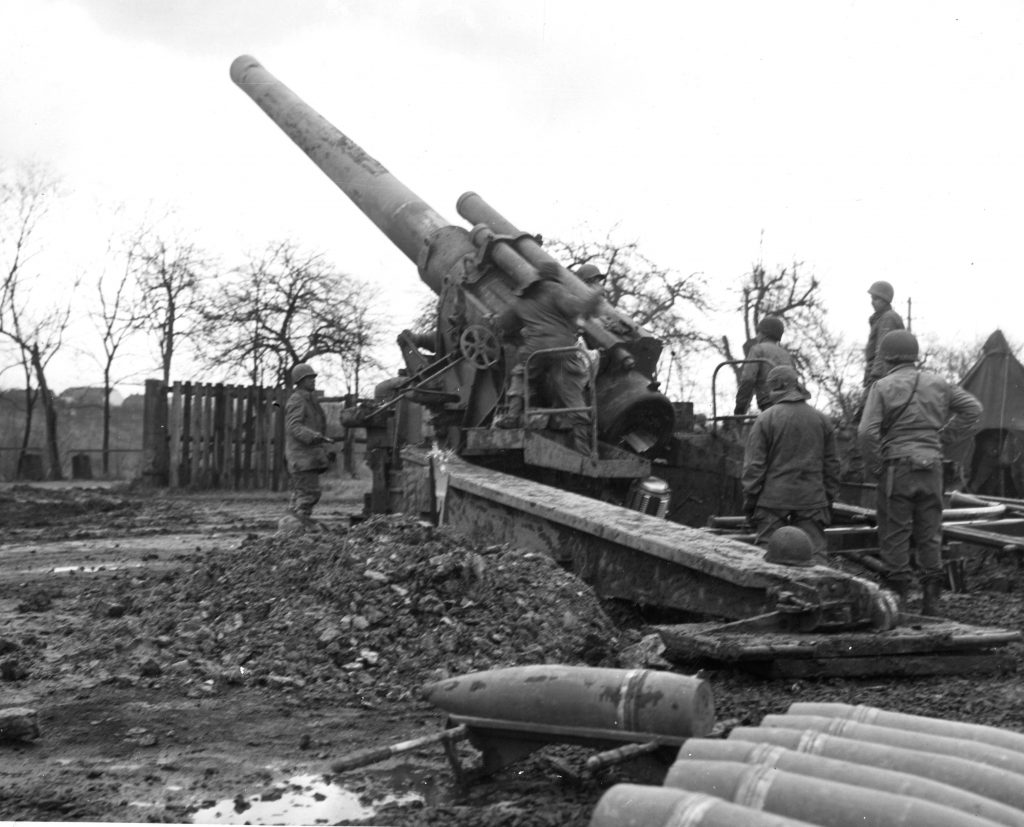(Document source: Original After Action Report, 35th Infantry Division, December 1, 1944 – December 31, 1944.
 The 35th Infantry Division, with the exception of one battalion, began the month of December 1944, its sixth month in combat during World War II, in Corps Reserve. Although rest, rehabilitation, and cleaning of weapons and equipment had a high priority, combat training classes were also conducted. The firing of weapons, assault of pillboxes, and the use of special assault equipment were included in the training. The assembly areas for the regiments were as follows, 1/137 and 2/137 were at Béning-lès-Saint-Avold, Bistroff, and Harprich, France while the 3/137 was assembled in the towns of Frémestroff, Altrippe, and Leyviller, France, with the mission of protecting the division’s northern flank. The 134-IR assembled its troops in Lixing-lès-Saint-Avold, Vahl-Ebersing, Lelling, and Biding, the 320-IR being at Pontpierre, Guessling-Hémering, and Vahl-lès-Faulquemont. The division’s period in Corps Reserve during December, however, was short-lived and lasted less than one day.
The 35th Infantry Division, with the exception of one battalion, began the month of December 1944, its sixth month in combat during World War II, in Corps Reserve. Although rest, rehabilitation, and cleaning of weapons and equipment had a high priority, combat training classes were also conducted. The firing of weapons, assault of pillboxes, and the use of special assault equipment were included in the training. The assembly areas for the regiments were as follows, 1/137 and 2/137 were at Béning-lès-Saint-Avold, Bistroff, and Harprich, France while the 3/137 was assembled in the towns of Frémestroff, Altrippe, and Leyviller, France, with the mission of protecting the division’s northern flank. The 134-IR assembled its troops in Lixing-lès-Saint-Avold, Vahl-Ebersing, Lelling, and Biding, the 320-IR being at Pontpierre, Guessling-Hémering, and Vahl-lès-Faulquemont. The division’s period in Corps Reserve during December, however, was short-lived and lasted less than one day.
 At 2300, December 1, 1944, the order to relieve the elements of the 6-AD during the night of December 2/3 was given to the unit commanders. Following this relief, the 35-ID was to attack at 0400, Dec 4, and seize objectives in the vicinity of Ernestviller, Heckenransbach, and Grundviller, France.
At 2300, December 1, 1944, the order to relieve the elements of the 6-AD during the night of December 2/3 was given to the unit commanders. Following this relief, the 35-ID was to attack at 0400, Dec 4, and seize objectives in the vicinity of Ernestviller, Heckenransbach, and Grundviller, France.  The Division was then to continue the attack over the Sarr River. The 134-IR with Able Co of the 60-ECB (Engineers) and Able Co or the 654-TDB, in direct support, was on the left; the 320-IR, supported by Charlie Co of the 60-ECB (Engineers), and Charlie Co of the 654-TDB, was on the right.
The Division was then to continue the attack over the Sarr River. The 134-IR with Able Co of the 60-ECB (Engineers) and Able Co or the 654-TDB, in direct support, was on the left; the 320-IR, supported by Charlie Co of the 60-ECB (Engineers), and Charlie Co of the 654-TDB, was on the right.  The 137-IR constituted the division reserve. Supporting the Division was the 182nd Field Artillery Group (one light and one medium Battalion reinforcing fires of the 216th Field Artillery Battalion), the 1135th Engineer Combat Group, and two truck companies, the 443rd Quartermaster Trucks Co and the 2905th Quartermaster Trucks Co. The relief of the 6-AD went off as planned. The first unit to move to the front was the 3/320, which closed into Kappelkinger at 0100, on December 2. The 134-IR closed into the vicinity of Saint-Jean-Rohrbach at 1540 and the 3/134 relieved elements of 6-AD (Combat Command B) by 2210. During the afternoon, the 1/320 moved to the vicinity of Insming and the 2/320 to the vicinity of Hilsprich. The 137-IR, in division reserve, moved its battalions to Linstroff, Erstroff, and Gréning. The 134-IR and the 320-IR were now on the line of departure poised for the attack.
The 137-IR constituted the division reserve. Supporting the Division was the 182nd Field Artillery Group (one light and one medium Battalion reinforcing fires of the 216th Field Artillery Battalion), the 1135th Engineer Combat Group, and two truck companies, the 443rd Quartermaster Trucks Co and the 2905th Quartermaster Trucks Co. The relief of the 6-AD went off as planned. The first unit to move to the front was the 3/320, which closed into Kappelkinger at 0100, on December 2. The 134-IR closed into the vicinity of Saint-Jean-Rohrbach at 1540 and the 3/134 relieved elements of 6-AD (Combat Command B) by 2210. During the afternoon, the 1/320 moved to the vicinity of Insming and the 2/320 to the vicinity of Hilsprich. The 137-IR, in division reserve, moved its battalions to Linstroff, Erstroff, and Gréning. The 134-IR and the 320-IR were now on the line of departure poised for the attack.
At 0400, Dec 4, during the blackness of early morning, both regiments jumped off. To produce the element of surprise, no artillery preparation preceded the attack. It was hoped the enemy would be caught napping and this was found to be true in the 134-IR sector. The leading battalions, the 1/137 and the 2/137, silently moved toward and into Puttelange-aux-Lacs and captured 73 sleeping enemy soldiers in foxholes and buildings. Once awake the enemy countered with small arms, mortar, and artillery fire. But the damage had been done and by 0930, Puttelange-aux-Lacs was declared clear by the 1/137 while the 2/137 had taken the high ground north of the town. During this time, the 3/137, in regimental reserve, moved to a new assembly area at Diffembach-lès-Hellimer. In the afternoon and evening, the two battalions drove on the clear Guebenhouse and Ernestviller and outposted the towns during the night.
The element of surprise in the 320-IR sector was less successful. Immediately after jumping off, it ran into an enemy column of foot soldiers. The 2/320, on the left, met heavy enemy resistance consisting of small arms and automatic fire, after crossing the Mutterbach River north of Rémering-lès-Puttelange. The 3/320 met considerably lighter resistance in securing the village of Hellering. At 0810 the Battalion had one company entering Betting, and another company immediately following. The battalion then advanced on Holving, left one company to clear it, and proceeded. At 1850, the 1/320 moved from the regimental reserve to advance toward Ballering, seizing the town at 0110 on the morning of Dec 5. That night the battalion proved that AT minefields can be used effectively in combat offensive. Fearing the enemy might move down the road southeast into the town and strike the battalion which had not been able to bring up his AT guns, the CO ordered a hasty minefield be laid on the road with machine guns covering the minefield.
It paid dividends. Several hours later a column of enemy vehicles moved down the road. The lead vehicle hit a mine and exploded. The machine guns opened immediately and peppered the column. The enemy turned and ran. The morning of Dec 5 found the attack continued at 0800. The 134-IR advanced rapidly. Taking Heckenransbach and Woustviller quickly, the regiment had the 2/134 in the outskirts of Sarreguemines and the 1/134 sent patrols through the Sarreguemines Forest up to the Sarre River by dark. The 3/134 moved to a new assembly area in the vicinity of Neufgrange and pushed advanced elements to the high ground overlooking the Sarre River. The 320-IR’s drive proceeded the morning of Dec 5. The 1/320 moved on and seized Richeling and continued to advance up to the vicinity of Willerwald. The 2/320 reached Grundviller at 0840 and went on to Heckenransbach, previously taken by the 134-IR, Hambach, and then secured Siltzheim. The 3/320, in regimental reserve, followed the 2/320 and closed into Hambach at 1900. All battalions conducted reconnaissance of the Sarre River during the night.
On Dec 7 and 8, the 35-ID moved closer to the Saare River and made recon and preparations to cross the river. In the 134-IR zone, the 2/134 cleared Sarreguemines as far east as the Sarre River. The 2/320 sent Fox Co to the high ground west of Zetting and the 3/320 dispatched Love Co to Wittring, both of which are river towns. The 137-IR, meanwhile, had moved to new assembly positions at Richeling, Holving, Ballering, Diderfing, and Bertering. The order for the division to cross the Sarre River on the morning of Dec 8, was issued the night before. During the night, the 134-IR and the 320-IR continued their recon of the river and made preparations for the crossing.
At 0500, the crossing began. The 1/134-IR crossed the railroad bridge south of Sarreguemines and completed the crossing at 0525. The 2/134 and the 3/134 were both over 90 minutes later. Heavy resistance was then encountered. The 1/134 moved northeast along the right side of the railroad tracks methodically clearing out the buildings in that vicinity. On the left side of the tracks, the 2/134 progressed and by noon entered the woods southeast of Sarreguemines. Both Battalions battled heavy small arms and 20-MM fire. Along the east bank of the river, the 3/134 advanced rapidly and mopped up the town of Sarreinsming during the morning. At 1130 the enemy counter-attacked the 2/134. 13 to 15 enemy tanks carrying infantry bore down upon the battalion from Neunkirchen. In 15 minutes the enemy dispersed and the attack was broken up when fire from all organic, reinforcing, and Corps artillery was brought down upon it. The rest of the afternoon the 2/134 and 3/134 made little gain but the 1/134 cleared Stembach, a small village bordered on the north by the railroad tracks and on the west by the Sarre River.
In the sector of the 320-IR, the 2/320, crossing by assault boats, landed on the east shore of the Saare River at 0745 where enemy machine-gun fire was met. In the middle of the regimental zone, the 1/320 crossed and pushed its bridgehead as far east as Didering, which it cleared. The crossing of the 3/320 was held up at Zetting by direct fire from the east bank. The 1/320 and the 2/320 gained a few hundred yards the remainder of the day and made preparations to continue the next morning. Under the cover of darkness that night, the 3/320 crossed at Wittring on a footbridge constructed by the 60-ECB. The enemy attempted a second counter-attack against the division on Dec 8 when tanks and infantry moved against the 320-IR. Once again, artillery, this time assisted by an airstrike, broke up the attack. Organic and reinforcing artillery fired a Time on Target (TOT), immediately followed by the airstrike, which in turn was followed by another TOT by heavy Corps artillery. In addition, 12 TDs from the 654-TDB fired on the attacking force from positions west of the Sarre River and knocked out at least one tank. During this time, the 60t-ECB and the supporting 1135-ECG attempted to construct vehicular bridges in the vicinity of Wittring and Sarreinsming but extremely heavy enemy artillery fire prevented it. Also on Dec 8, the 137-IR moved its battalions to Hambach, Siltzheim, and Neufgrange.
 On Dec 9, the 35-ID enlarged its bridgehead over the Sarre River. However, the 134-IR made little gain due to very heavy enemy fire. The 1/134 and the 2/134 held their positions while the 3/134 gained several hundred yards in capturing Hill 271. The 320-IR had more success on Dec 9. The 3/320 drove northeast at 0800 and seized Hill 311, located about 1000 Meters north of Wittring. There it made contact with the 1/320 on the left and the 328-IR (26-ID), on the right. Pushing on two more kilometers, the 320-IR secured Weisviller by nightfall. Attacking in conjunction with the 3/320, the 1/320 reached positions 300 Meters north of the Zetting – Weisviller road when darkness came. The 2/320 moved east, cleared the small woods southeast of Zetting; switched its attack to the north, and reached the south edge of the Lehwald Woods.
On Dec 9, the 35-ID enlarged its bridgehead over the Sarre River. However, the 134-IR made little gain due to very heavy enemy fire. The 1/134 and the 2/134 held their positions while the 3/134 gained several hundred yards in capturing Hill 271. The 320-IR had more success on Dec 9. The 3/320 drove northeast at 0800 and seized Hill 311, located about 1000 Meters north of Wittring. There it made contact with the 1/320 on the left and the 328-IR (26-ID), on the right. Pushing on two more kilometers, the 320-IR secured Weisviller by nightfall. Attacking in conjunction with the 3/320, the 1/320 reached positions 300 Meters north of the Zetting – Weisviller road when darkness came. The 2/320 moved east, cleared the small woods southeast of Zetting; switched its attack to the north, and reached the south edge of the Lehwald Woods.
The 137-IR, in reserve since the beginning of the attack, prepared to move into the fight. The 1/137 was dispatched to the southwest part of Sarreguemines, closing at 0835, when it began clearing snipers in the city. The remainder of the regiment moved to the west bank of the river during the night of Dec 9/10, preparatory to the crossing. During this time, engineers of the 60-ECB and the 1135-ECG had difficulty constructing vehicular bridges across the river. Enemy artillery was so intense it was practically impossible to work on the bridge. Despite this handicap, they managed to complete the class 40 bridges at Sarreinsming at 2235 and at Wittring at 2217. Construction of these bridges was greatly facilitated by the assistance of the 81-CSGC (Chemical Smoke Generating Company) which smoked the bridge sites effectively enough to prevent enemy observation. The company, composed of Negro soldiers, accomplished its first mission in combat despite severe artillery concentrations directed against it. Seven casualties were suffered.
On Dec 10, all regiments continued the drive to enlarge the bridgehead at 0730. Continuing the attack astride the railroad track toward the northeast, the 1/134 and the 3/134, punched at strong enemy resistance in Folpersviller and gained the high ground southeast of the town overlooking the Blies River. The 2/134, meanwhile, cleared out Le Grand Bois (Forest) and assembled in regimental reserve in the northwest portion of the woods. At daylight, the 2/137 and the 3/137, crossed the Sarre River at the railroad bridge and immediately attacked. The 3/137 cleared a factory in southeast Sarreguemines and drove northeast to seize Neunkirchen, Germany.
The 2/137 became engaged in bitter hand-to-hand combat, fighting from machine guns to machine guns with fixed bayonets, rifles, machine guns, and hand grenades in a large porcelain factory east of Sarreguemines. This fierce fighting continued for four hours before the enemy finally withdrew. The 1/137 remained in Sarreguemines on the west side of the river. During this time, the 1/320 and the 2/320 flushed the woods in Lehwald. The 1/320 then drove on to seize Petit Viesing Eme and Grande Viesing Eme while the 2/320 extended its positions to the east to include the whole northern edge of the Lehwald Forest with the mission of holding the position against possible counterattack. On the right of the 1/320, the 3/320 moved as far north as the crossroads about 1000 meters east of Lehwald.
On Dec 11, the 35-ID drove to the German border with only the Blies River between it and German soil. During the morning, the 1/134, entered Folpersviller, and during the afternoon and evening pushed toward Frauenberg. The 3/134 cleared Blies – Ebersing, putting both battalions on the west bank of the Blies River. In the morning, the 3/137 moved on to capture the huge airport east of Sarreguemines and pushed on to the Blies River to seize Frauenberg. The 2/137 continued mopping up east Sarreguemines, capturing a German prisoner of war camp, and liberating approximately 1000 Russian, Polish, and Italian POWs, some of whom had been captives of the Nazis for five years. The 1/137, during this time, moved to the east part of Sarreguemines and occupied that part of the town. In the sector of the 320-IR, the 1/320 and the 3/320 advanced north. The 3/320 pushed to within 1000 M of Bliesbruck where it was halted by heavy enemy fire. On the left, the 1/320 drove to the railroad where it stopped for the night and sent patrols to the Blies River. The 2/320 remained in the Regimental reserve.
